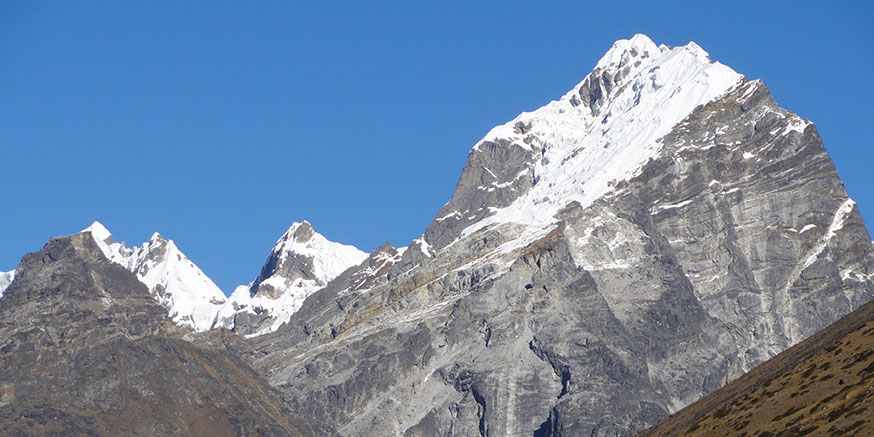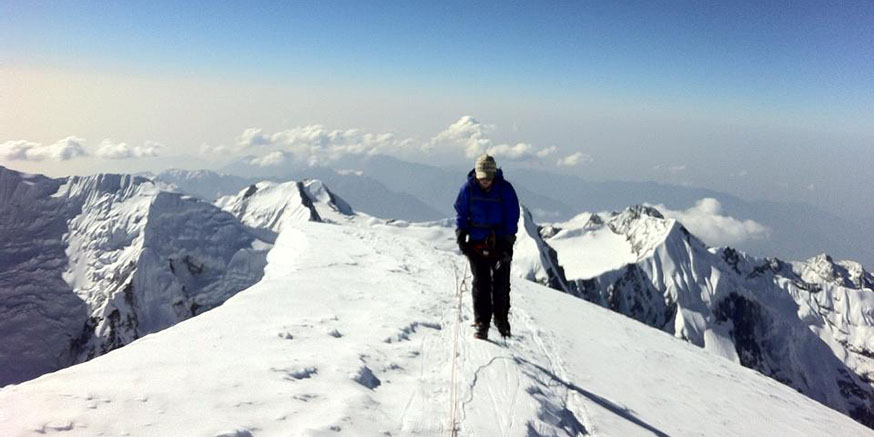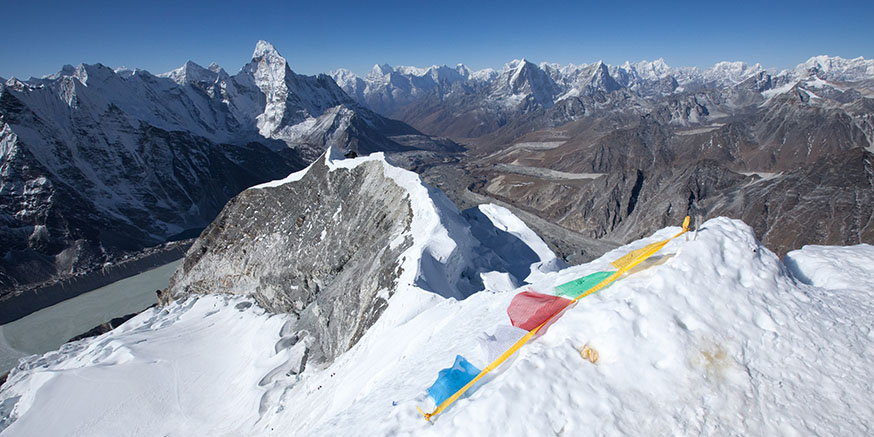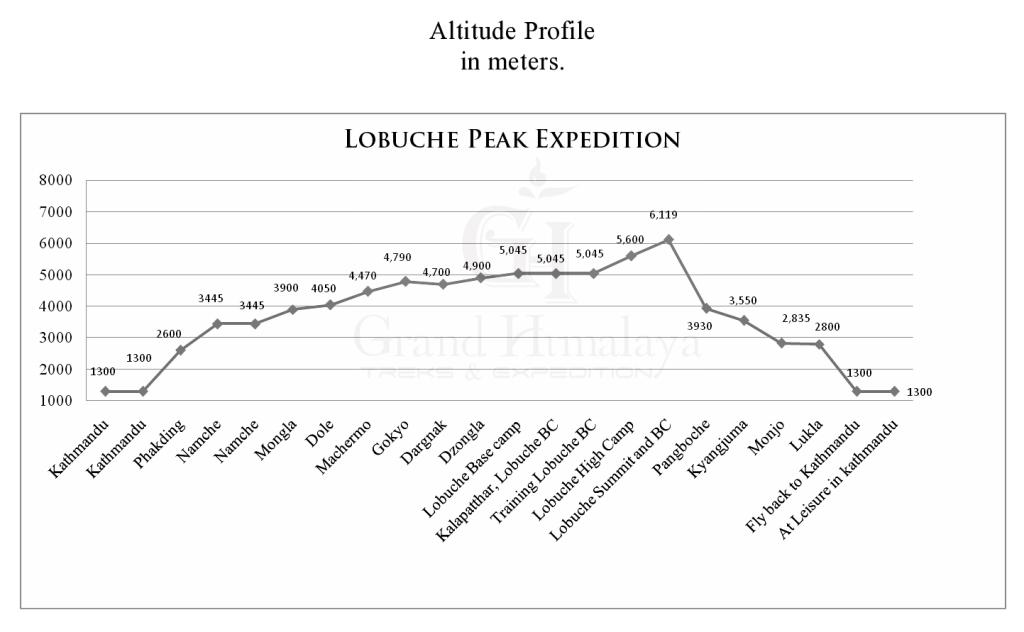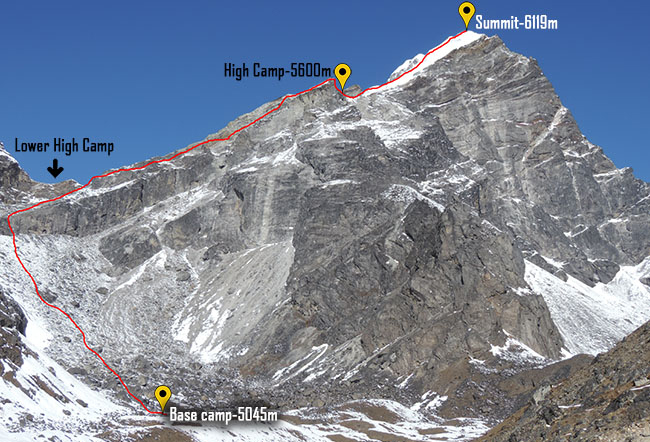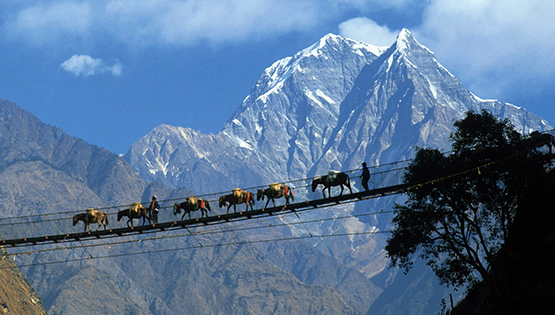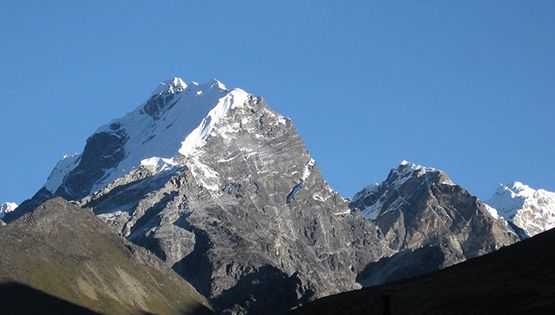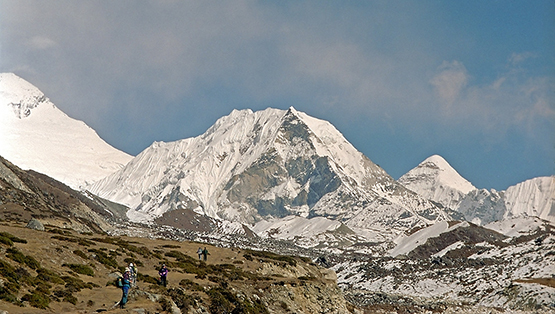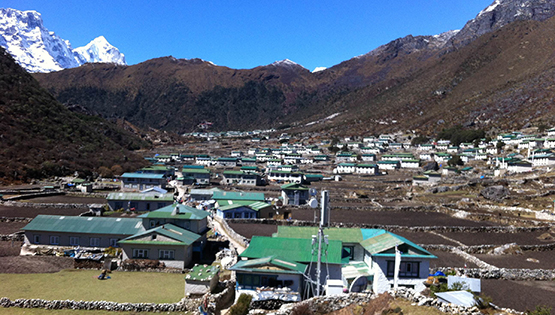The Lobche or Lobuje Mountain consists of two different summits, viz. East and West with heights of 6,119 m and 6,145 m respectively. A continuous ridge connects them but there is still a sharp gap and a considerable distance between them. The East Peak is recognized as a trekking peak, whereas the West is known as an Expedition Peak. Lobuche being an attractive mountain offers various existing routes and also a potential for new ones. The dark triangle of its rocky East face rises over the moraines of the Khumbu Glacier to a spectacular skyline, forming the south ridge. Descending a marked notch and climbing steep snowy slopes to the top reach the peak of Lobuche East. On most occasions, the mountain is climbed on the summit ridge only as far as a subsidiary snow summit, southeast of the true peak and before the notch. This peak is identified as the false peak. To reach the true summit of Lobuche East, which is a continuation on the knife-edged ridge heading North West, and it is another couple hours climb from the false summit. A fall here would be disastrous. Very few climbers who attempt this peak reach the real summit, but mostly attain the worth-while false summit. Good conditions and a dawn or pre-dawn start is recommended. Laurence Nielson and Ang Gyalzen Sherpa made the first ascent to Lobuche East on 25 April 1984 although there are possibilities that others have reached the summit before. But no records are available.
Lobuje Peak is officially classified as a group trekking peak by Nepal Mountaineering Association and this peak offers a challenging climb but attainable climbing objective and is an ideal mission for trainee mountaineers. The peak is regarded as the hardest of the trekking peaks. The climber must be proficient in using climbing gears like ice axes and crampons etc.
A very warm welcome to the Kingdom of Himalayas. Upon your arrival at the Tribhuvan international airport our representative welcomes you and assists you transfer to your hotel in Kathmandu. After time to get refreshed, evening you'll meet and transfer for welcome dinner in one of the typical Nepalese restaurant in the heart of Kathmandu i.e. Utsav or Nepali Chula (Kitchen). Here you will not simply experience the traditional Nepalese dish but will be entertained with Nepalese traditional dance and folk songs. After the dinner, you will be transferred back to your respective hotel.
Kathmandu is the historical and cultural heart of Nepal and has been a popular destination for tourists ever since Nepal opened its doors to visitors. The city presents a wonderful mix of Hinduism, Tibetan Buddhism and Western influence in the Valley. Bauddhanath: Stupa with its 130 ft. dome. One of the world's largest Stupa, Bouddha is generally acknowledged to be the most important Tibetan Buddhist monument outside Tibet. Pupshupatinath Temple: Pashupatinath is considered one of the holiest shrines of all the Hindu temples. The temple has remained the presiding deity of ruling Nepalese Royalty. -After the city tour, our leader or guide will do the final briefing of the expedition. They will also take the opportunity to check the members' personal equipment as the city bazaars and climbing shops will provide the last chance to correct any deficiencies. Overnight at Hotel.
It's a panoramic thrill flying into Lukla in a Twin Otter plane on a clear day. The views of snow-capped mountain peaks sprawling around you outside your plane are almost ecstatic, beginning a whole chain of memorable experiences that stay with you for a long, long time. This is an exciting flight, which should give a glimpse of Everest in the distance. In Lukla, we will meet our trek staffs and porters and set off straightaway for our first night's stop at Phakding 2600m. Situated on the banks of the Dudh Kosi, which drains the whole of the Khumbu Region, this small hamlet is on the main trade route through the area and there are a number of clean, well-built lodges where we can spend the night.
We will continue up the banks of the Dudh Kosi, crossing it twice by small suspension bridges before reaching the Khumbu National Park. We will then cross the confluence of the Dudh Kosi and the Bhote Kosi on a high suspension bridge and climb steeply for about two hours up 'Namche Hill' to reach Namche Bazaar (3,400m/11,155ft). This is a prosperous trading town and the capital of the Khumbu Region. Many Tibetans cross the nearby border to trade their wares and the local market is a fascinating spectacle. This is a good place to buy genuine Tibetan artefacts. Just across the valley to the east stand the peaks of Thamserku and Kangtega, both very impressive mountains.
Namche Bazzar is the highlight of EBC trek and the heart of the Everest (Khumbu) region which has government offices, ATMs, Internet cafes, shops, restaurants, a bakery and a colourful market each Friday evening and Saturday. This is first scheduled 'acclimatization' day for this trek. Health experts always recommend us to stay active and moving during the rest day too instead of being idle. If we trek few hundred meters vertical during the day, it will help us to acclimatize with the alien heights that we are going to confront on the trek. Having been born, leading and organizing trips in the Himalayas, we believe in the natural process of acclimatization... "Climb high, sleep low". We take an interesting side trip up to Khumjung and climb up to famous airstrip at Syangboche. Just above the airstrip is the Everest View Hotel (3800m), a Japanese scheme to build a deluxe hotel with great views of the highest mountains on Earth. The Khumjung valley surrounded by the snowy peaks of Kongde and Thamserku, and the sacred peak the Khumbiyul-lha hosts a well known monastery that houses a yeti scalp. Visit Hillary School which is at the same site and spending some time in Khumjung after having lunch there, we walk back down to Namche Bazaar. Overnight in Namche Bazaar.
After 1 and 1/2 hour of walk on a nice and wide flattish track, we'll get to a place called Kyangzoma, an intersection of a traditional route to Everest Base Camp and route to Gokyo. The credit all goes to Mr. Pasang Sherpa who spends all his days assembling donations from passersby, with the help of which he amends the well-worn track. After kyangzoma, we’ll take left turn and then follow steep up for around couple hours, until we arrive at Mongla. Note that descending to Phortse Tenga would mean sleeping only 100 meter above Namche, although a lot of trekkers do so. Spending a night here in Mongla rather than Phortse Tenga will surely be a plus point to your acclimatization.
After the breakfast, it's a steep descent of 300 meters until we get to upper Phortse Tenga where you will see a single lodge nestled in the woods. Please keep your attention alert because this place is mostly inhabited by Impeyan Pheasant (Danphe) and Blood Pheasent. The trail climbs steeply out of valley through rhododendron forest, which gives away to fragrant stands of juniper and large conifers. This part of the trek is especially beautiful in spring when the rhododendrons are blooming. The trail passes through Yak Kharkas (Cattle pen) and summer settlements, and then climbs gently to Dole. The views of Khumbi-La and Tawoche are magnificent throughout the day, and it is possible to climb a ridge behind Dole for an even broader view up and down the valley.
Today is another short day starting with a climb out of the small Dole Valley before ascending more gradually up the Dudh Kosi Valley, high above the River. The walk is easy though we'll feel the effects of altitude on even the smallest hill. The barren alpine scenery with only small clusters of dwarf juniper and rhododendron are the stark contrast to the white snowy peaks and deep blue skies. After 2 hours we'll arrive at Luza (4360m) and after a further hour's walk, we reach our lodge at Machermo (4470m) where we spend the evening. After lunch there is an option of taking an excursion across rocky moraines to the base of Kyajo Ri (6168m) and Machermo Peak (6073m). However, keep an eye open for the yeti! It was here in 1974 that three yaks were killed and a Sherpa girl injured when trying to fight off a hairy, ape-like intruder!
A short, steep climb leads from the Machermo Valley on to the steep grassy slopes of the Dudh Kosi Valley. Keep an eye open for the colourful Tibetan snow cocks, often found in this area. The valley widens as we pass through Pangka (4390m) and on to the jumbled, terminal moraines of Ngozumpa Glacier, the largest in Nepal and the source of the Dudh Kosi River. Climbing steeply over a rocky trail we keep to the western side of the glacier to reach a small lake at the head of a wide valley and then pass a larger lake at Longponga (4690m), before following the lateral moraines to the third lake at Gokyo (4750m). Gokyo consists of a number of stone dwellings surrounded by stone-walled yak pastures. Our lodge is located close to the lake and, if there are no clouds around, the sunroom can be distinctly warm in the afternoon. For those feeling energetic, it is worth ascending to the ridge at the back of Gokyo for views down to the mighty Ngozumpa Glacier.
The earlier the better for an ascent of Gokyo Ri to catch the glimpse of the fresh morning sun, crowning some of the gigantic peak of the Himalaya. It takes between two to three hours to zig-zag our way up to the summit of this famous vintage point. The summit boulders are draped with prayer flags and the views towards Cho Oyu are particularly fine. We descend back down to Gokyo for breakfast, or, if we have made a particularly early ascent, we will continue towards Dragnak. From Gokyo Resort, the track climbs up gently towards the lateral moraine of the Ngozumpa glacier and then head due east across the Ngozumpa Glacier. The Ngozumpa glacier, below the sixth highest mountain in the world Mt. Cho Oyu, at 36 kilometres (22 mi), is the longest glacier in the Himalayas. The route across the moraine of the glacier is on mostly sandy trails that weave amongst the 'moonscape' of the glacier, before reaching the far side and the small hamlet of Dragnak (2 hours from Gokyo). We will stay at Chola pass resort in Dargnak.
This is a big day. We need to set off very early in the morning to ensure that we cross the Cho La and descend to Dzongla in good time. At first we make a very gradual ascent alongside the river up a small valley to eventually reach a sandy ridge line, which gives a great view of the Cho La ahead and to the north east. There are some impressive 6,000m peaks to be viewed from here. To the north - the rocky Nirekha Peak and Kangshung Peak, and to the south, the icy bulk of Cholatse. We make a long, gradual descent on a pleasant grassy path to reach the bottom of the pass. From this point the ground becomes more technical and it is time to pack away our trekking poles. The route weaves around boulders at first, before climbing up onto rockier ground and a final steep section to reach the top of the pass. This is on loose ground, which can often be icy, so we need to take great care and it might be that we fix a short section of rope and use crampons especially if it is covered with snow and ice. Conditions on the pass can vary considerably, so we stick on the safe side and bring crampons with us just in case. The top of the pass is glaciated and we walk across a flat section of snow for about 15 minutes before dropping off the side and back onto rock. With Dzongla and the entire Everest valley now in sight, before we pick our way down the far side of the pass and descend into a lovely valley, we cherish this marvellous sight with our lunch and drink. A stream that meanders along the bottom leads us to the lodge at Dzongla and a well-deserved rest. Thank god that finally their came up two new lodges in Dzongla which has lessen the changes of skipping this place and carry on to Lobuche, due to shortage of room.
The trail from Dzongla descends a little and then contours steadily around Awi Peak, before joining the main Khumbu Valley and reaching Lobuche Base camp. There are yet more superb views today, including towards the distinctive north face of Ama Dablam, Pumori, Lingtren, Nuptse, Lhotse, and many more. You will be amazed and overjoyed to see the cosy spot we have choose for our base camp. It is perfectly nestled among the big boulders and well sheltered from the wind, with a crystal clear lake nearby. At base camp, you will meet the rest of the expedition crews with the rest of our expedition gears and logistics. From this day until the successful ascent of the peak, we are actually camping and sleeping in our tiny little castle "Tent".
About three hours beyond Lobuche we reach Gorakshep, a tiny hamlet at 5,180m, which used to be the site of the 1953 Everest expedition's base camp. We'll take a short break at Gorekshep for a cup of tea/coffee or quickly check emails in the world's highest cyber cafe. The ascent of Kala patthar from Gorakshep is demanding but the climber gets the most magnificent mountain panorama, "Mt. Everest" the highest point on the planet at 29,028ft (8,848m), towers directly ahead and on all sides loom the other giants, Mt. Lhotse, Nuptse, Pumori, Chagtse, and countless others. We make a quick descent to Gorakshep and retrace our steps back to Lobuche base camp.
After the sun crawls on your tent in the morning, the kitchen crews will show up at your tent with choices of wake up drinks. Sometimes the peculiar noise of Khongma (Himalaya Partridges) will not simply interrupt your slumber but increase your curiosity to hop out of your tent to have a glance of this holy bird. The breakfast under the clear blue sky, on the lap of Himalayas is something you indeed deserve of. After lunch, the sherpas will do some fix line on one of the boulder at Base camp and teach you some useful climbing skills. The climbing skills cover the appropriate handling of climbing equipments and the technique of using Jumar and Abseil device on a fix line. Some training experience before the real mountaineering adventure will boost up your confidence and climbing skills, thus increasing the chances of scaling the summit as well as fully enjoy the experience.
Today, after having an early lunch we climb up to the Lobuche High Camp which takes us about 4 hours. The High camp is located at 5,600m/18,368 ft. From Base Camp, we hike on a loose scree slopes and climb the tricky part of the gully before arriving at lower high camp on a flat rocky ridge. Some people use this as a high camp, which resulted into starting early in the morning in fish cold night when the possibly of reaching the top is at the minimal. The sherpas might put some fix line just below the high camp on a last steep rocky section. Upon reaching the high camp, we set up our camp and enjoy the view of the Everest valley.
An early start (around 4am) sees us climbing the south East Ridge, which is a mixture of moderately steep snow and ice. Where necessary, we fix ropes along the route. We ascend steadily to a plateau at around 6000m, and then traverse around to an exposed ridge, which we will follow to the summit slopes. Approximately 4 hours of steady climbing brings us to the far eastern summit, which for almost every Lobuche East climbers marks the summit. The main east summit is not far in distance but requires some technical climbing which is normally beyond the ability of novice climbers, certainly in terms of the time it would take. From the top we are well rewarded with superb views across to Mt. Ama Dablam , Mt. Makalu, Mt. Lhotse, Mt. Everest, Mt. Nuptse, Mt. Changtse (in Tibet), Mt. Pumori, Mt. Gyachung Kang, Mt. Cho Oyu and the myriad peaks to the west and south. After a full day's climbing, we retrace our steps back to High Camp, pack up, then with weary legs descent to Lobuche base camp. The day's climb could be anywhere between seven to nine hours, depending on conditions and our progress.
We retrace our steps to Lobuche and descend down the Khumbu Valley, stopping for a break in Dugla. With more views of Ama Dablam ahead of us, and of the north face of Tawoche, we continue along a flat valley to Pheriche. Pheriche has a wide range of lodges and also a Himalayan Rescue Association Medical Post. From Pheriche, it's a gentle downhill climb to Pangbocho.
Following the main Everest trail down the beautifully scenic valley, we pass through Pangboche at the base of Ama Dabkam and cross the river before climbing to the monastery at Tyangboche. Here we will no doubt take advantage of the bakery, as well as spending some time exploring the famous monastery. A circuit of the monastery, with its many prayer wheels is not to be missed, as is an exploration of the inside. From Tyangboche, a steep descent of around 1500ft/500m leads through bird filled rhododendron bushes and fir trees to the Dudh Kosi River. The final steep climb traverses the hill side into Namche Bazaar and from here we will descent continue to Kyangjuma (3,550m/11,545ft) to spend the night.
Crossing on yet another suspension bridge; we climb up the opposite side of the valley to reach the contouring path leading back to Namche Bazaar. We should have enough time in Namche to shop and relax in the bakery with a coffee and a cake, or even to check the Internet. A steep descent for 600m/2,000ft down Namche Hill leads to the suspension bridge crossing the Dudh Kosi river and the small village of Monjo (2,835m/9,300ft). Not only is Monjo a quieter place to stay than Namche, it also means our porters have a less strenuous walk back to Lukla tomorrow.
The trail now flattens out and we cross the river twice more before a rising traverse up the hill-side, past numerous tea-houses to Lukla. Our last day of steady trekking will be a real joy as at lower altitudes, with two weeks behind us, and nothing left to prove, we can soak up the atmosphere in each of the villages we amble through. All excess energy is guaranteed to be exhausted at our party this evening with our Nepalese crew.
Saying final goodbye to our porters, we fly back to Kathmandu after our long mountain journey. The flight time to Kathmandu are scheduled in the morning normally because Lukla suffers a lot of wind afternoon. Sometime the flight time can be delayed due to bad weather and other reasons. The early morning flight drops us at Kathmandu and the Grand Himalaya van or coach will transfer you to the hotel.You may have time to relax after long journey and take back your breath and rest at your hotel with ending your Himalayan expedition. Remember, we will be hosting a fantastic celebration dinner together in the finest restaurant in Thamel, in occasion of successfully completing your Lobuche peak climbing!
Rest and relax at the hotel after such a wonderful trip. The day is also reserved as a contingency day due to flight delays or other unforeseen conditions. For those eager to see as much of Kathmandu as possible, an early start is worthwhile to visit the temples of Pashupatinath and Swayambhunath and districts of Bhaktapur and Patan. Durbar Square is also on the essential list, as is the shopping area of Thamel. In the evening you can have your last night in Nepal, enjoying the Nepali cultural dinner show or go out to Thamel.
Today is free or last minute shopping for souvenirs or gift to your family, friends or relatives for you until your departure flight/drive or to commence any extra trips or activities you may have booked with us. If departing, you'll be transferred to the International Airport for your departure flight to your onwards destination.
- 4 night hotel accommodation in Kathmandu in a 4 star category hotel. Breakfast is included. Accommodation is on a twin share basis. Single rooms are usually available at an additional cost. Please inform us as early as possible if you wish to have a single room.
- One day guided city sightseeing tour in & around Kathmandu (largest Buddhist stupa in the world at Bouddha Nath and most important Hindu temple in the valley at Pasupati Nath and famous Monkey temple Swyambhunath). Either before or after the trek with fully licensed tour guide and transportation. Other city tour will be arranged by us on request for additional cost if you wish and have spare day.
- All Entrance fees for all tourist sites listed in our itinerary.
- Lobuche Peak climbing permit/Sagarmatha National park entry fees,Khumbu Pasang Lhamu Rural Municipality Entrance Fee & all government taxes.
- Return Domestic flight ticket KTM-LUKLA-KTM (In a Fixed wing Twin Otter) all guests, a Guide & local staff.
- All pickup and drop transportation from airport to airport both domestic & international airports. All guests are kindly requested to try and arrange your international travel flight to arrive at Tribhuvan International Airport (TIA) in Kathmandu at same time (if possible), helping us to avoid multiple journeys to airport during the peak season.
- Domestic airport taxes.
- One locally made water Proof Duffel bag with your Name & Grand Himalaya's Logo on it will be provided by us for the Trek, it is yours so you may take it back to home with you or return to us at the end of trip if you wish.
- All meals during the trek period, 3 times a day Breakfast/Lunch/Dinner/all hot drinks/2 liters of proper boiled water per guest per day for drinking. Meal can be selected from the tea house menu according to individual choice.
- An experienced Local Sherpa guide who knows the area, mountain, local people & culture very well.
- Assistant Sherpa (4 climbers = 1 assistant guide).
- Appropriate number of porters, 1 porter between two guests.
- Farewell dinner in Kathmandu after the trek, local cultural music and Dance show in a well reputed restaurants, Bhojan Griha/Nepali Chula/Utsav with guide/staff (TBC)
- Insurance coverage of accidental death, Medical expenses & emergency Helicopter evacuation for all local staff.
- All porters properly insured & equipped.
- 1 Bottle of SUMMIT Oxygen with set of mask and regulator will be provided during the trek, (Just for emergency medical use only).
- A comprehensive medical kit. All guests are requested to bring your own personal First Aid Kit with sufficient medication supplies for trip.
- One regular/simple cell phone with local SIM Card & charger cable will be provided in the team during the trip. Guest will be requested to return this to Grand Himalaya staff at the end of the trip.
- Travel and rescue arrangements.
- International & home country domestic airfares, transfers en route & excess baggage.
- Your personal insurance: Medical, mountain rescue cover and repatriation is obligatory.
- Your personal expenses e. g phone calls, laundry, alcoholic beverage, mineral/bottled water, charges of showers, cost of electronic devices charging facilities and wireless internet (Wi-Fi) fees in the tea house.
- Main meals (Lunch & Dinner) in Kathmandu apart from celebration meal (Allow up to USD12-15 per meal).
- Your Nepal entry visa fee (US$50 available on entry) Valid for 30 days.
- Tipping in Nepal & Tibet is customary. (Allow USD:300 and above/Per guest)
- Excess baggage above 15 kg will be extra charged USD: 1.5 per kg during the peak season.
- Extra night accommodation in Kathmandu because of early arrival, late departure, early return from mountain (due to any reason) than the scheduled itinerary.
- Personal Climbing/Trekking Gear for the trip.
Note: Please be advised, an extra cost of USD500-800/-per guest will be applicable for chartering a private Helicopter in the event of bad weather disturbance on the fixed wing twin Otter flight IN/OUT of Lukla.
| # | Start Date | End Date | Trip Cost | Availability | Booking |
|---|---|---|---|---|---|
| 1 | 28 MAR 2025 | 19 APR 2025 | $3800PERSON | Available | Book Now |
| 2 | 15 APR 2025 | 7 MAY 2025 | $3800PERSON | Available | Book Now |
| 3 | 3 MAY 2025 | 25 MAY 2025 | $3800/PERSON | Available | Book Now |
| 4 | 4 OCT 2025 | 26 OCT 2025 | $3800/PERSON | Available | Book Now |
| 5 | 22 OCT 2025 | 13 NOV 2025 | $3800/PERSON | Available | Book Now |
A deposit of 35% of the total trip cost is payable at the time of booking and the final balance due 12 weeks before the start of the trip. The act of booking implies that you have accepted the ethos of the trip and any objective or subjective risks associated with it.
